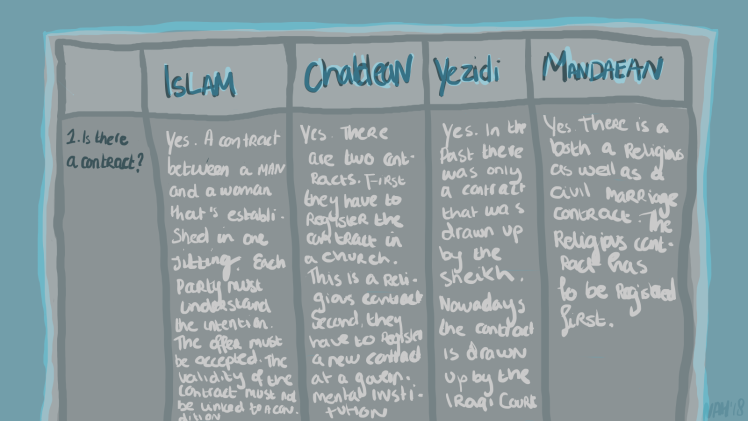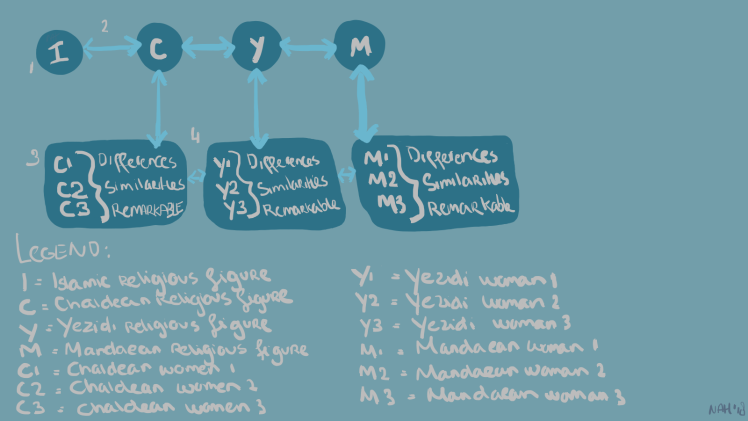Godforsaken Women
The world often forgets that the Middle East was once a vibrant heterogeneous region. It is easy to discount the various minority inhabitants of the region when sectarian violence between the two main Islamic factions rules the news reports. Ever so often however, the world jolts awake. The recent wake up call was the news on the sexual enslavement and torture of Yezidi women. The world was outraged and called for immediate measures to be taken. Interestingly, a Yezidi priest requested a change in attitude from its community. The priest requested his congregation to welcome the Yezidi girls, who were freed from their captors, in their community again. In the past these communities often shunned women who were raped or converted to Islam. This meant that women were ousted from their communities due to the conservative environment that places a stigma on rape. This horrendous case is a clear example of the double discrimination that women who belong to a religious minority group in the Middle East face. First, women are vulnerable to attacks and discrimination due to their ethnic origin. Second, these women are discriminated on the basis of their gender. This notes a duality in the position of women who belong to a minority. Double discrimination is one of the effects of this duality. Understanding issues such as these, that can lead to double discrimination, is difficult due to the secretive and reclusive nature of minority communities. This research project aimed to shed a light on the difficult position of women in these minority groups. For now, I will only post my introduction and methodology on this space. I will update this site once my paper with the content of the interviews is published. My goal is to cast the unique content of this research project in a creative design mould that will do justice to the stories of these women.
This research project focused on women belonging to a minority group in Iraq. Iraq, the modern state that houses the region that is historically known as Mesopotamia, has always had an ethnically and religious diverse population. The position of minorities in Iraq has always been precarious. Minorities could maintain their ethnic and religious culture and traditions, but they were subjected to the whims of the dominant majority. In uncertain and insecure times, the majority would often change its views towards the minority. The status of minorities would become unstable. This led minority groups to become reclusive and maintain their traditions and cultures in secrecy.
There are several minority groups in Iraq. However, this research project focused on three ethno-religious minority groups, namely: Chaldeans, Yezidi’s and Mandaeans. Ethno-religious minorities are minorities whose ethnicity is linked to their religion. In these cases an individual is born into a specific ethnic community that is linked to a religion. These two factors cannot be separated from each other. The individuals within such a community share both their ethnic identities as well as the same religion. It is rare or in some cases even not possible to convert to an ethno-religious minority group.
The reason why ethno-religious minorities will be analyzed instead of minority women at large is, because minority women do not experience the same duality as described above. Naturally these women also have to deal with discrimination due to their gender, but some of these groups belong to the majority’s religion or the majority’s ethnic population. For example, the Kurds are an ethnic minority within the state of Iraq but at the same time belong to the dominant religion of the state.
Ethno-religious minorities are recognized in the Constitution of Iraq and in other legislation, but women are either subjected to adhere to laws based on the Sharia, which contradict their own beliefs and traditions, or left out and allowed to settle matters in their own ethno-religious communities. However, ethno-religious minority groups do not have stable and consistent rules on affairs with regards to women. Often, elderly men decide cases on an ad-hoc basis. Additionally, the fact that ethno-religious minority groups are reclusive leaves women in a vulnerable and unstable position.
Unfortunately research regarding ethno-religious minority women is extremely sparse. This is due to the fact that the communities are reclusive and are reluctant to talk to outsiders. The vulnerable position of ethno-religious minority communities created an environment in which minorities were afraid to express their ethno-religious identity. Therefore a major portion of this research project focused on identifying the position and the rights of these women within their communities.
This research project examined the position of ethno-religious minority women and the double-discrimination that they face regarding family law matters. Issues regarding family affairs affect all women. Marriage, divorce and inheritance are topics that affect their daily lives. In the case of ethno-religious minorities it becomes even more interesting. Iraq is a state party to a number of international treaties that affects the position of women. In addition Iraq also has a number of state and regional level legal instruments regarding these topics. However, Iraq’s state religion is the Islam. Legislation that has been ratified by Iraq, whether on an international or state level, makes reference to the rules of the Islam. Ethno-religious minority women do not adhere to the teachings of the Islam, but at the same time their daily lives are influenced by the same legislation. If women are allowed to adhere to their own religious rules that regulate family law, then these rules are often not codified, and can clash with legislation at the international, state and regional levels. There is also a lack of information on what happens within the local communities of these women. Local level rules that affect women within the community are often not codified. In addition it is also unclear how the interaction between the different levels affect the position of ethno-religious minority women regarding family law. Therefore research that examines the problems ethno-religious minorities face has to examine both codified as well not codified rules at various levels of legislation. Research is necessary in order to examine what the position of ethno-religious minority women regarding family matters within their own communities is. This research project therefore focused on the position of ethno-religious minority women regarding their family law rights within three different layers (local, regional and international) of the legal society.
Methodology
A part of this research project was traditional legal literature research, but the majority of this research project was based on interviews with both religious figures as well as ethno-religious minority women. The paragraph on this website will elaborate on the methodology of the interviews.
Literary sources on the legal position of ethno-religious minority women in Iraq regarding family law matters are close to non-existent. Therefore this part of the methodology equipped a different method. It was necessary to hold interviews with religious scholars to map out the legal position of ethno-religious women regarding family law issues. However, it was also important to analyze how their position functions in practice. Therefore, interviews had to be also held with ethno-religious minority women. These women had to have an active role within their ethno-religious communities and either experienced or have knowledge of the cases that are the vocal point of this research project. Regarding the qualifications of religious figures it was important that they either held official positions as religious leaders or that they were involved in assessing cases of women regarding marriage, divorce and inheritance.
Mapping Out the Rules
There is a severe lack of information on the religious rules that govern the lives of ethno-religious minority women. A methodology had to be established to map out the rules of the three unique ethno-religious minority groups in a systematic way. Each of these three ethno-religious minority groups might have different religious rules that govern marriage, divorce and inheritance. This part of of the research could have easily become an entangled web of different religious rules. It was therefore of utter importance to organize these rules in a methodical way.
The starting point was the information provided in Iraq’s personal status law of 1959. Each rule that governs the topic of marriage (including polygamy), divorce and inheritance was added to the table. Subsequently each Islamic rule could be coupled to a question. For example, article 6 paragraph d of Iraq’s personal status law states that a marriage contract is valid if two witnesses who bear legal competence are present during the establishment of the marriage contract. The question that can be linked to this condition is: do witnesses have to be present? If so, how many and do they have to bear legal competence? All the relevant Islamic rules from the personal status law were dissected and coupled to questions. These were then used as interview questions for the religious scholars. All this information was accumulated in a table. The table has 4 cells. The first cell is titled Islam. As described above, this cell consists of the codified rules stated in Iraq’s personal status law of 1959. The second, third and fourth cell consist of the religious rules of the Chaldeans, Yezidis and Mandaeans. These rules were derived from the interviews held with each religious figure.

Interview Analysis
The scope of this project was limited, therefore the amount of interviewees that could be interviewed was limited as well. I developed a cross-analysis methodology to analyze the answers as the population group was limited due to the scope of the project. By cross comparing the data the answers could be verified. Furthermore, I wanted to delve into how the relationships between the different actors are interlinked. The cross examining method allowed me to compare the answers on similarities, differences and remarkable comments that each actor made.
The method is best described through the chart below:

Figure 1: interview method Source: authors (Nóra Al Haider) own chart
Legend
Legend
I Islamic religious figure Y1 Yezidi woman 1
C Chaldean religious figure Y2 Yezidi woman 2
Y Yezidi religious figure Y3 Yezidi woman 3
M Mandaean religious figure M1 Mandaean woman 1
C1 Chaldean woman 1 M2 Mandaean woman 2
C2 Chaldean woman 2 M3 Mandaean woman 3
C3 Chaldean woman 3
In diagram 1 the different comparisons that are made throughout the interviews are illustrated. There are four types of comparisons. Each type is numbered in the diagram 1. Number 1 illustrates the answers of the religious subjects that were compared to one another by looking at the differences and similarities of their answers. Remarkable comments that each religious figure made were also added to the analysis.
Number 2 illustrates the comparison between the answers of each ethno-religious group of minority women and their respective religious figures. The analysis looks at similarities, differences and remarkable comments.
Number 3 illustrates the comparisons between the answers of individual women within each ethno-religious group of the same religion. Differences, similarities as well as remarkable comments are analyzed.
Number 4 illustrates the comparison between the three ethno-religious groups of women that were interviewed. Differences, similarities as well as remarkable comments are analyzed.
Results
The local, state, regional and international (family law) rights of ethno-religious women have never been mapped out in a systematic and thorough way. The results of the interviews that I held with both the women and the scholars provided new and unique information regarding their legal position. My goal now is to publish the interviews and the legal analysis in an academic paper. After publication I would like to create an online platform that keeps track of the rights of ethno-religious women and shines light on their position. I will update my portfolio page with more information once the paper has been published.
Project Details This blog post is a heavily abridged version of my research project. It will be edited throughout the next few months with more examples and illustrations once the paper is published. Status: finished Publication: in progress
Copyrighted by Nóra Al Haider 2016
